Sorry, this entry is only available in Français and Nederlands.
Back to the North !
The first two Bewick’s Swans equipped with a GPS tag during past summer in the tundra of Yamal but at the same site a few days apart, have very recently left their wintering site separated one of the other by … 8000 km!
The first to take the northern route is the adult female 832X. She left Poyang Lake area (southeast China) on 03/03/2016. She had arrived in the region on 25/11/2015 and has successively visited the Sai Hu lakes, Longhu and Longgan lakes. So she stayed a total 99 days near the Yangtze River before resuming her migration back to the north.
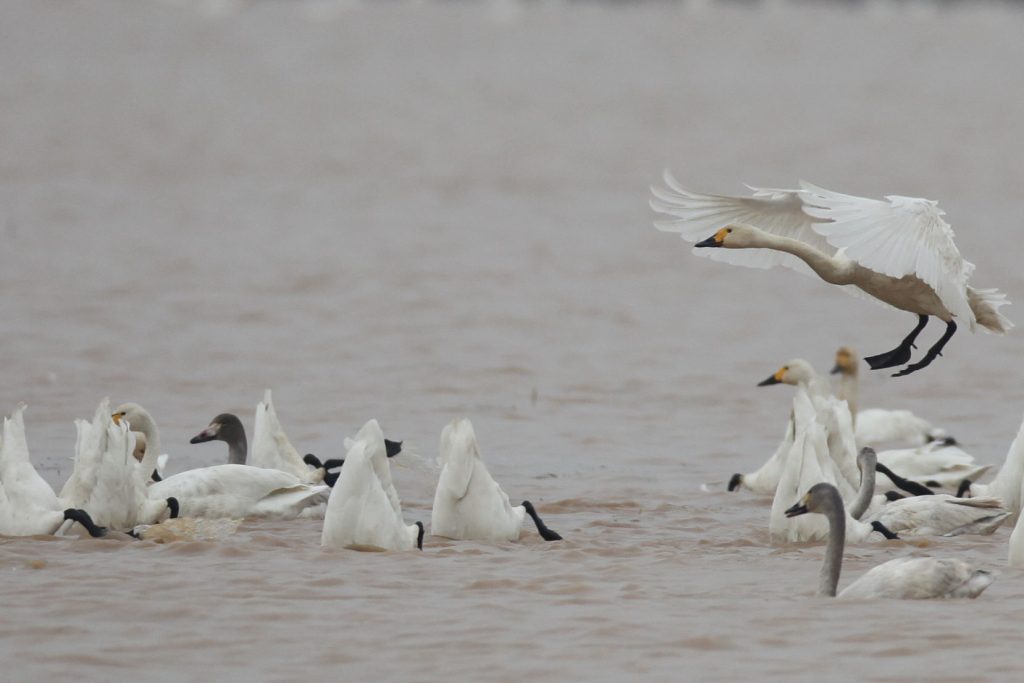
Between 03/03/2016 and 07/03/2016, 832X has traveled 1400 km to the north-northeast with a maximum peak of 215 km in 3 hours. Since she is in halt on the Yellow River in the district of Donghan, 250 km from the border with Mongolia. This is exactly where 865X, another Bewick’s Swan from Yamal having wintered in the Yangtze region, had stopped in last autumn migration.
The second Bewick who started the spring migration is 854X. It is a second-winter male that had (after years of questions !) indicated us the route to the Evros Delta. 854X had arrived in the Evros on 12/12/2015.
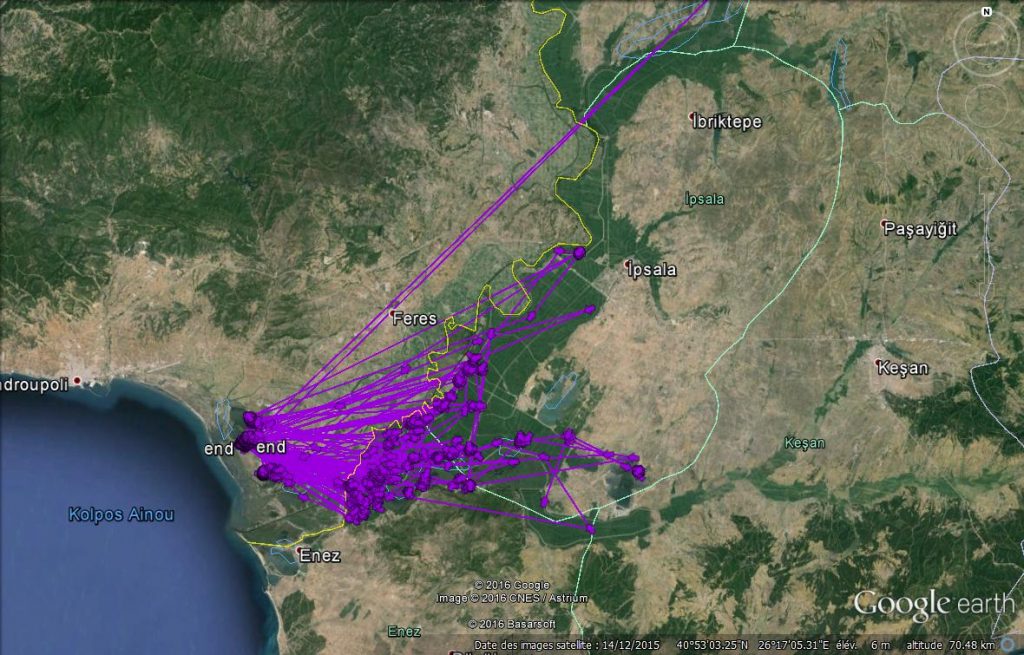
After 86 days of back and forth between Greece and Turkey, the Evros river making the border between the two countries, 854X flew in the late afternoon of 07/03/2016, heading northeast. In a step of 12 hours of continuous flight and a peak of 265 km traveled in 3 hours, 854X flew over the Black Sea in almost straight line to land on the morning of 08/03/2016 in the Nature Reserve of Chernomorsky, just east of the Bay of Tendra, Ukraine.
Twelve hours later, 854X set off again, this time eastward, for a flight of three hours maximum. At nightfall, he landed at sea, a few km off the Gulf of Khorli, a site where gather in the summer thousands of Mute Swans in flightless moult.

The GPS positions received suggests that during the night, 854X drifted 11 km towards the east. At dawn on 09/03/2016, he took off for a short 90 km flight which led he to the impressive hyper saline lagoons of Sivash, north of Crimea. He stayed there four days and was located several times in cropland area close to water bodies. Most likely he was feeding there.
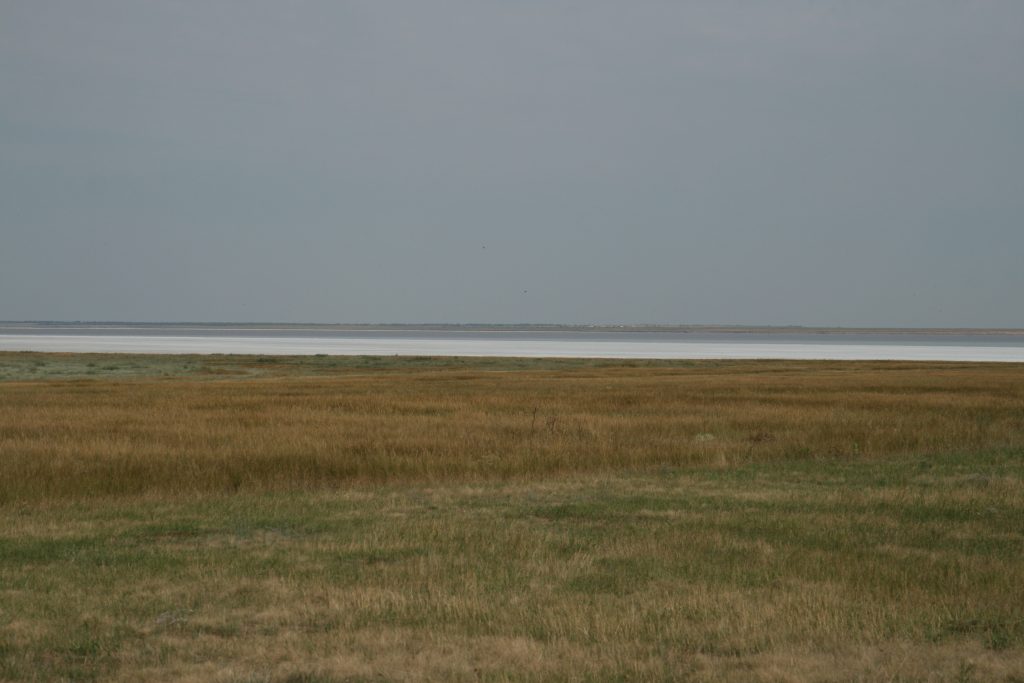
854X then resumed flight to the east for about 40 km. New stop at night, but this time on Sea of Azov. And new drift during the night, up to 24 km from the coast this time. This morning, 14/03/2016, 854X resumed its journey shortly after 05:00 am (local time) always towards the east. Six hours later he was located 290 km to the east, probably when flying. 854X was then close to Beisug liman where he has stopped 51 days during post-breeding migration 2015, prior to arrive in the Evros Delta. Will he halt there again or will he continue his journey eastward to Russia and Kazakhstan?
To be continued !
Bewick ‘s Swan with yellow neckband and Lesser white-fronted Geese
February 10, 6:50, like every morning watching the swan roost begins at sunrise. Thousands of swans, mainly Bewick, gathered to spend the night safely in the marshes of Dimitriades. The flock lies on 1 km; this is a very impressive sight!
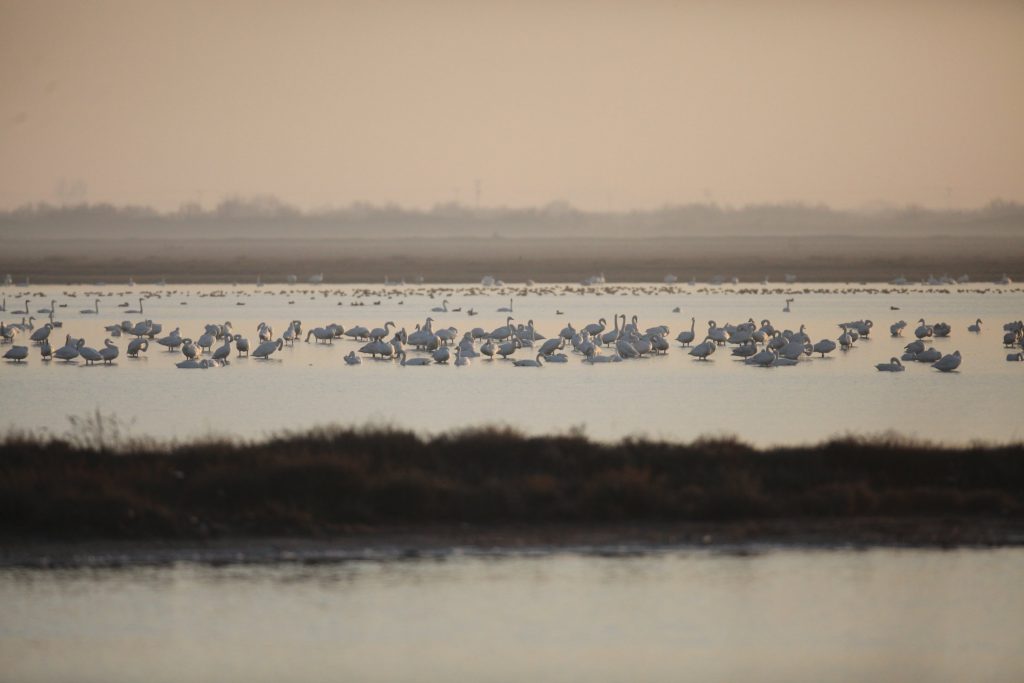
Most swans are swimming in shallow water, a minority is standing on the flooded mudflats. The contacts are intense, swans are very social birds outside the breeding season. They constantly vocalize. Their calls are very melodious and reach their climax when taking off. Flocks follow each other at regular interval.
8:03, two families of Bewick’s Swans take flight from the southwest corner of the roost. In doing so, they give off the view to another small group. He’s there ! The Bewick’s Swan with the yellow neckband observed there 5 days ago. But at the time the code could not be read. It makes a lot less windy today and the distance is only 400 m. It will works! After a few minutes of scrutinizing with the telescope at 70x zoom, the 4-characters code appears. No more doubts, it’s a Bewick’s Swan ringed in the Netherlands. Encoding the code on geese.org platform that compiles data from swans and geese tagging programs in Europe allows to immediately know its origin. That swan was marked on 26/12/2014 in Noord Brabant, near the city of s’Hertogenbosch. He quickly left the area to continue its wintering in Belgium, 50 km south-west, in the north of the province of Antwerp where he remained until 01/03/2015. He will then be observed on 31/03/2015 in Lithuania, when migrating to Siberia. And next winter he is now in Greece.
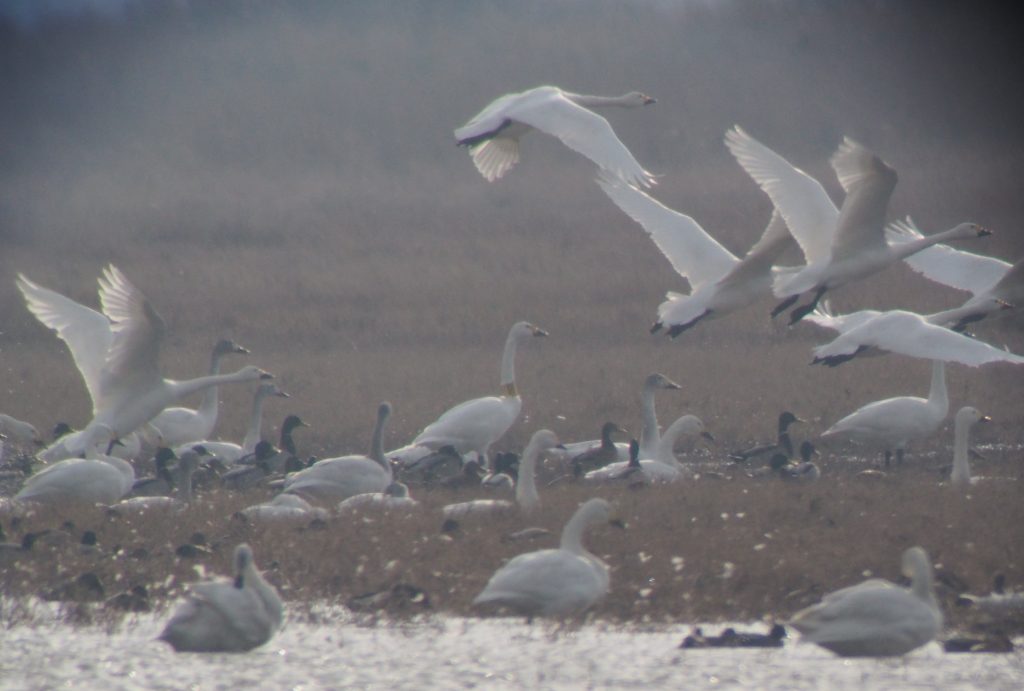
This is the third Bewick’s Swan ringed in the Netherlands we are seeing in the Evros Delta. The previous was on 19/02/2010. Is this a new indication of the fact that the Bewick’s Swans traditionally wintering in this country are now deserting it ? But if that’s the case (3 observations do not allow to draw conclusions) why such a phenomenon? What happens in the Netherlands making that the country is no more favoured by the Bewick’s Swans ? Obviously, no one knows for sure.
Next objective of the day : search for Lesser white-fronted Geese, another species in decline which also winters in the Evros Delta.
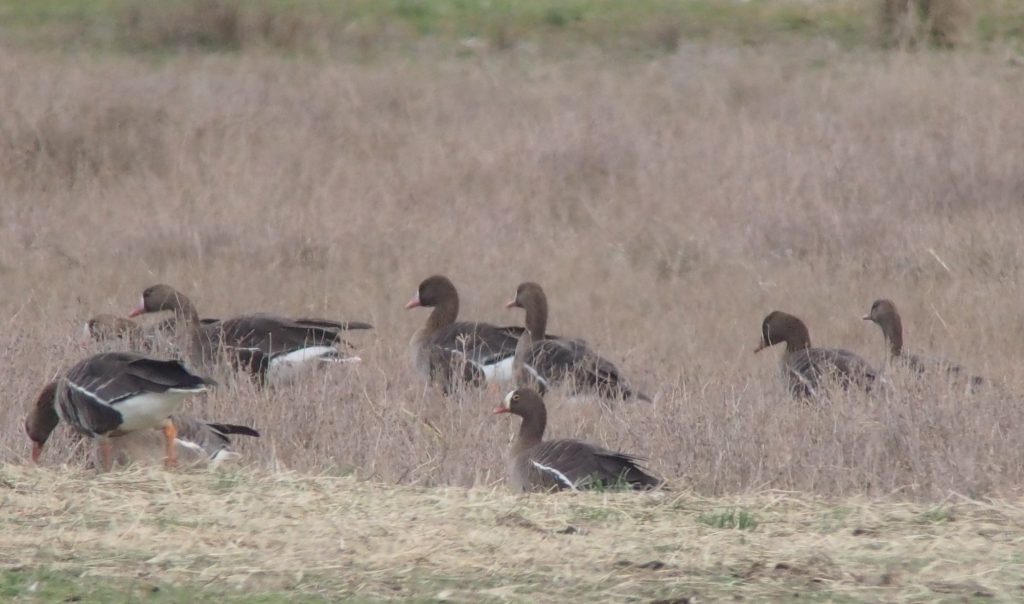
Ornithologists of the Forest Research Institute of Thessaloniki, a partner to the program on Bewick’s Swan, study their diet by analyzing the cell fragments of plants, extracted from droppings collected in the marsh Dimitriades. What a program!
The foraging sites of 854X
09/02/2016, the objective of the day: to identify the characteristics of the foraging sites of 854X, the Bewick’s Swan “sentinel” equipped with a GPS transmitter in Siberia.
The data transmitted from the arrival of the swan in the Delta of Evros indicate that it forage exclusively in the Turkish part of the Delta. The reason is simple: this area is covered by 99% of rice fields. Natural habitats, which contribute to the exceptional biodiversity of the Greek part of the Delta, were completely destroyed on the Turkish side. It is striking to observe a satellite map: east of the river, everything is a deep green: it is the rice fields. While to the west, a patchwork of colors of various shapes and sizes can be observed. There are obviously areas that are cultivated on the Greek part but not intensely while in coastal areas, salt marshes and lagoons stretch out of sight.
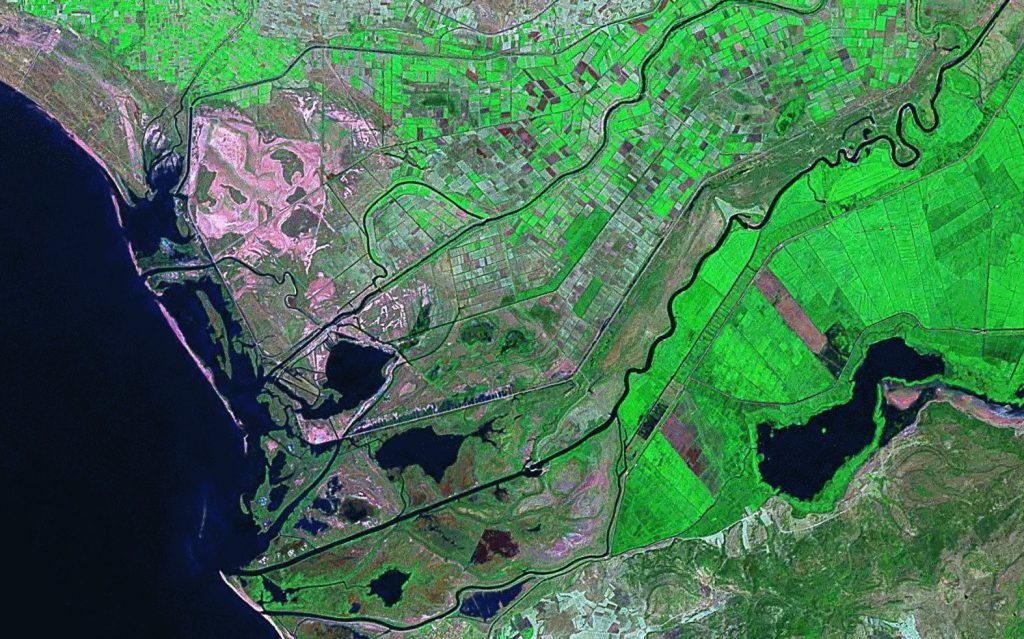
Let’s go to Turkey. A part of the rice fields is completely dry, the stubbles left after harvest line up in endless furrows. Another part is partially flooded, the bottom of the grooves being filled with water probably consecutively to the rains of the past week. A third part is completely under water, forming lakes of several km². It is on these flooded fields that gathers the majority of swans. Part of the area cannot yet be surveyed because it is under military control.
Most swans are found together in 4 huge flocks of 1500 to 4000 individuals. Small groups with a few dozen to a few hundred swans are scattered here and there. The large flocks are composed of three species of swans: Mute, Bewick’s and Whooper. All are feeding on the roots of the rice plants that were planted last spring. All sites where 854X has been located, and that could be visited, are indeed flooded rice fields.

Apart from swans, there is almost no other birds in this part of the Delta. This is probably the consequence of the disappearance of natural habitats and the development of rice monoculture. A very important hunting pressure is another explanation: at regular intervals in each rice field one may see hunting huts when gun cartridges litter the ground by the hundreds. At 14:45 in the middle of a group of 2,700 swans feeding in a flooded rice field near the village of Enes, there he is. 854X is carefully preening.
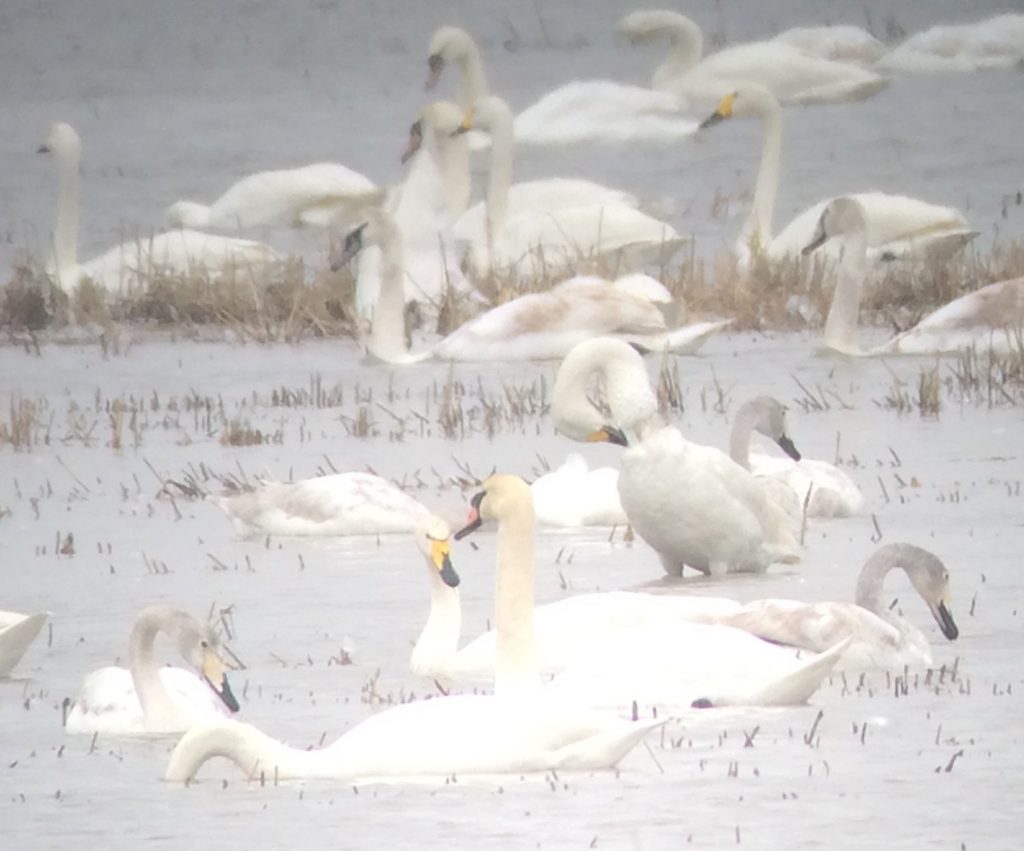
It’s a chance because yesterday it was located 26 km north, near the village of Ipsala. There are exactly 179 days we were together at the mouth of the river Yuribey on the shores of the Arctic Ocean.
A day is not another
It freezes this Monday 8 February 2016 at the border between Europe and Turkey. The day is dedicated to count waterfowl – swans, geese, ducks, waders and gulls – and raptors wintering in the National Park of the Evros Delta. Among these have been observed today: 2 White-tailed Eagles, two Imperial Eagles, about 20 Greater spotted Eagles, sixty Common Buzzards and as many Marsh Harriers, a Peregrine Falcon, about 15 Kestrels, a dozen European Sparrowhawks. The two Rough-legged Buzzards discovered the day before yesterday were no longer found.
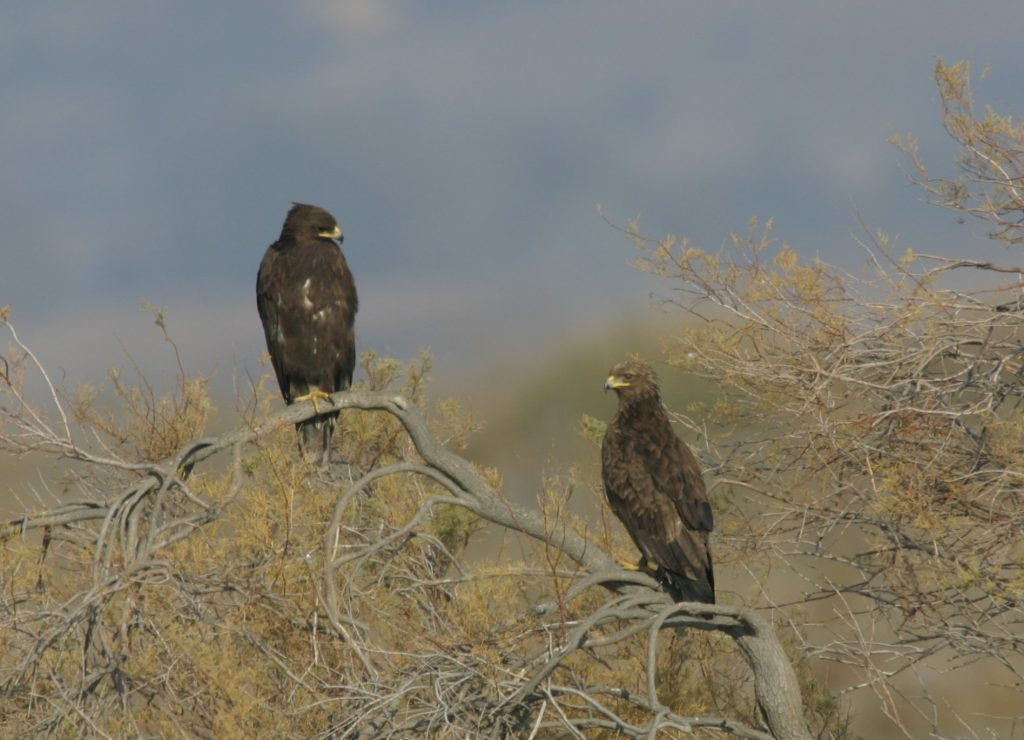
Bewick’s Swans are of course always under close monitoring and the follow up of the arrival to the roosts starts at 16:00 from the dyke that separates the Drana Lagoon from the marshy area of Dimitriades. When arriving 7 Mute Swans were sleepy in the middle of the flooded area where past Friday 8500 swans from three species where gathering together. No movement or so until almost 17:15 when the young Imperial Eagle observed in the morning flies over the area towards the hills of Loutros where it roosts. 17:30, arrival of the first 8 Bewick’s Swans. The following 12 arrive at 17:35. At 17:46 p.m., it’s raining Ruddy Shelducks. 17:58 p.m. a flock of 28 Bewick’s Swans comes gently to rest on the water. 18:08 p.m., it is completely dark, end of counting. The total is doing 48 Bewick’s Swans. Yesterday they were in 1240, before yesterday 1400 and Friday 8400! Have the Bewick’s Swans wintering in the Evros Delta already started their spring migration to the tundra of Siberia?
The data transmitted by the swan 854X equipped with a GPS transmitter in Yamal are helping to understand these differences. Analysis of 854X positions at 02:00 am indicates that there is more of that one swan roost in the Evros Delta. Between 12 December 2015, the date of his arrival in Greece and 12 January 2016, 854X has used 8 different roosts, 4 located in Greece and 4 in Turkey. During this first month of presence, 854X slept 23 times in Greece and 8 in Turkey. So there is clearly a different distribution of swans between the roosts and between the nights. It is unknown why exactly, but we can assume that the weather is an important factor. This is one explanation to the variations in counts.
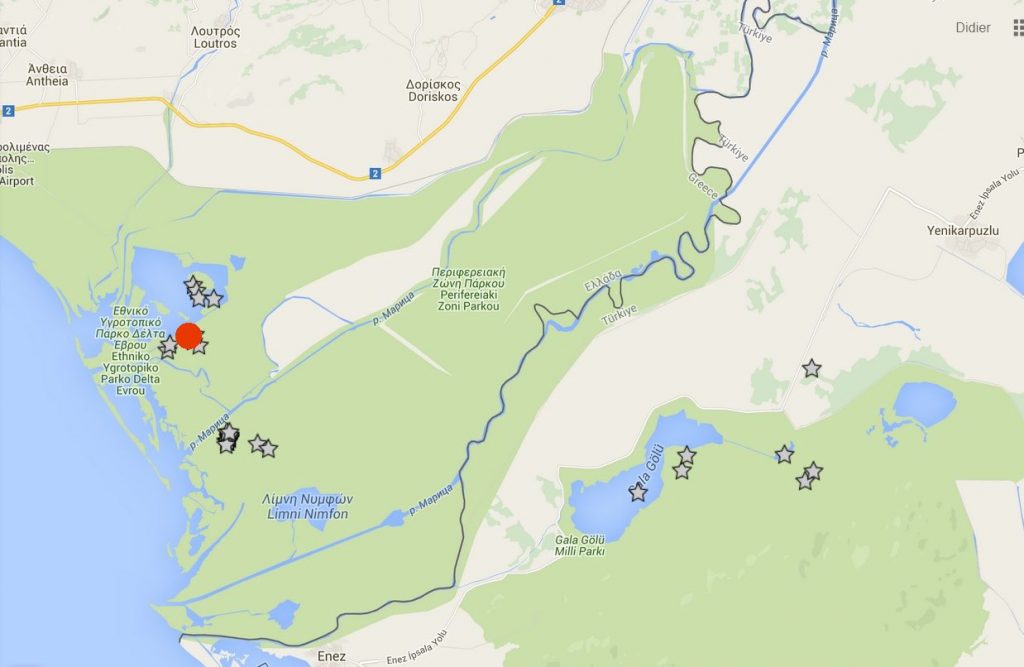
Another parameter explaining these disparities between the number of swans counted at Dimitriades roost is the timing of leaving foraging site at the end of the days. GPS locations of 854X and direct observations with a telescope indicate that foraging site are almost exclusively located in the Turkish part of the Delta. By the way a visit is planned in this area during the coming days.
Today 854X was still in Turkey at 19:00. Whereas it is dark at 18:10, so it arrived in the dark at the roost and has accordingly not been detected and therefore not been counted. Yesterday, 7 February, it was located at 19:00 7 km east of the roost; most likely flying. The same that today: he came to the roost in the dark and could not be recorded. Day before yesterday he was still in Turkey at 18:00 and was at the roost at 19:00. He returned earlier that day but still after or just after dark. And on 5 February, the story is already known, 854X and thousands of fellows spent all day in the roost of Dimitriades. They just have not been feeding this day. This most probably allowed the record count.
All this did not help to resight the swan with the yellow neckband observed, but not decrypted, on 5 February. It cannot more be found!
Even more Bewick swans in the Evros Delta
The weather conditions have changed rapidly in the Evros Delta, it is not infrequent. Since last night, the wind blows north northeast, gusting up to 70 km/h. It rained much all night and part of the day. The tops of the hills bordering the valley are covered with snow as the Greek side that Turkish. The temperature is around 3-4 ° C.
The data received every hour from the Bewick’s Swan 854X equipped with a GPS/GSM transmitter indicate that it has not left the roosting place this morning. It is therefore not going to feed on the other side of the valley, in Turkey, as he is doing every day since his arrival in the Delta. Is it something happened? Or will he plays, as expected, the role of “sentinel” that allows us to detect broader phenomena?
4 pm, we left for the Drana lagoon and the marshes of Dimitriades to see what happens. The track is particularly muddy, but it works. After a couple of km, the show is unique: we are facing a sea of swan! Most have their head tucked into their plumage. The others face the storm, trying to resist on their powerful legs. Some are in the water but very close to the shore to avoid being swept away by the waves. Others are dry, on the upper parts of the salt marsh. They are mostly lying to offer the least possible resistance to gusts. It is a unique spectacle, so much swans in such meteorological conditions and in such natural habitats.
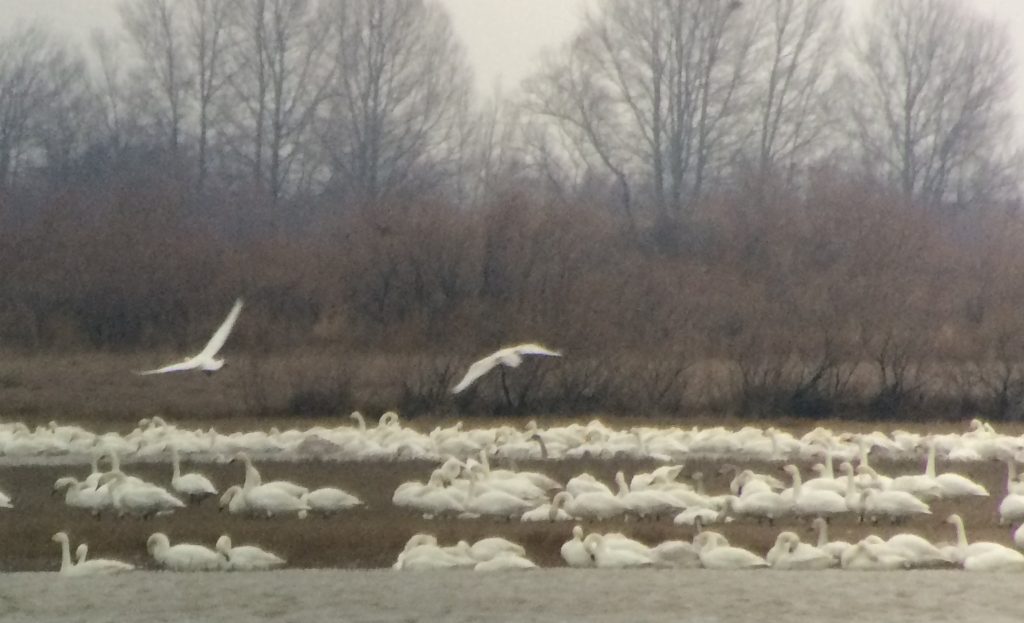
We estimate the number of Bewick’s Swans to 8400 which must be added circa 150 Whooper Swans and 50 Mute Swans. It is a new maximum for Bewick’s Swan for the site. But what happens in the Evros Delta? From where are these Bewick’s Swans coming from? From Yamal like 854X or from another places in the tundra of Siberia? Russian colleagues are particularly attentive to the problematic, the Bewick’s Swan is an endemic breeder of Russia. It focuses all the attention of the authorities and scientists in charge of the conservation of nature in the Russian Federation.
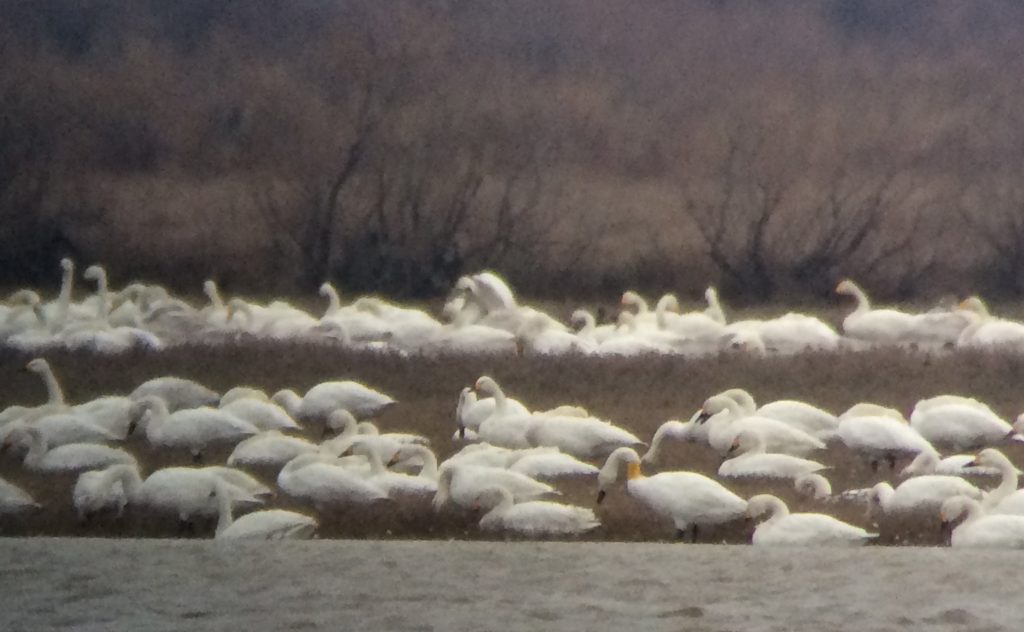
By watching and still watching this huge flock, our attention is drawn by a swan preening despite the strong wind. He stretches his neck, smooth, or rather try to smooth his feathers. It is marked with a yellow neckband engraved with a code enabling at distance identification. It is the fourth marked Bewick’s Swan we observe in the Evros Delta. This has certainly been ringed in the Netherlands by colleagues from the Netherlands Institute of Ecology. Despite our best efforts, we didn’t managed to read the code: it was not possible to come closer than 750 m, the light was fading to quick with the night falls, the wind vibrates the telescopes. We’ll be back tomorrow to try to find him !
The Incredible Evros Delta
5100, 5300, maybe even 6000! That’s the number of Bewick’s Swans counted the last days by the ornithologists working for the Evros Delta National Park. The previous record was set around 4500 individuals seen during the previous winter. The number of Bewick’s Swans wintering in Greece is therefore still growing while at the same time the flocks observed in traditional areas in the area of the North Sea are at their lowest.

This is not an easy task to count the swans in the Evros. Indeed, the Delta is shared between Greece and Turkey, making it difficult to carry out coordinated counts; there is also no local team of ornithologists on the Turkish side. Part of the delta is also under military control and therefore can be visited only occasionally and under strictly controlled conditions. In addition, the area of presence of swans is very large, about 350 square kilometers. Moreover a part of it is inaccessible when the river flow is so important that adjacent areas to the main branch are flooded. Additionally Bewick’s Swans are not the only representatives of their genus to winter in the Evros Delta. It is also the case for thousands of Mute Swans (from the steppe – or ancient steppes – of Ukraine and South of Russia) and Whooper Swans (most likely originating from the taiga of Siberia). The counts are therefore often slow and difficult as it is essential to carefully make the distinction between the three species. But the Greek team is particularly experienced, alternating on its territory and throughout the winter, weekly day counts and every two weeks evening counts at the roosts.
Starting today, and for 10 days, the Greek and Belgian teams are joining their force to study in the Evros the behavior of swans, their distribution between the different lagoons, their demographics by determining the proportion of young and brood size. The aim is also to go to see each site where the Bewick 854X equipped with a GPS transmitter on 14/07/2015 in the tundra of Yamal ( Siberia) has been located since his arrival in the Evros Delta on 12/12/2015. That will give the possibility to accurately determine the habitats used by this ” sentinel swan” and their relative importance. Such data are very useful for the conservation of the species giving the possibility, if necessary, to propose appropriate management measures. The GPS localization of the transmitter was set at 1 hour interval from today. This will provide even more accurate data in the coming days. This procedure will be limited in time because it is obviously energy costly and could drain the solar battery.
The sun is shining in the Evros today. Daytime temperature ranges between 10-15 °C. It turns out that almost all Bewick’s Swans left Greece to forage in Turkey. Moreover it has appeared that they didn’t came back on the Greeks roosting places before sunset. We have counted barely 150 individuals arriving at roost before darkness. But the evening was not lost! At 16:48 and then at 17:11 it is in a deafening roar that two compact waves totaling 4500 Ruddy Shelducks have arrived at the same marsh just south of Drana lagoon. This happens in the Evros Delta, and at European level, only in the Evros Delta!
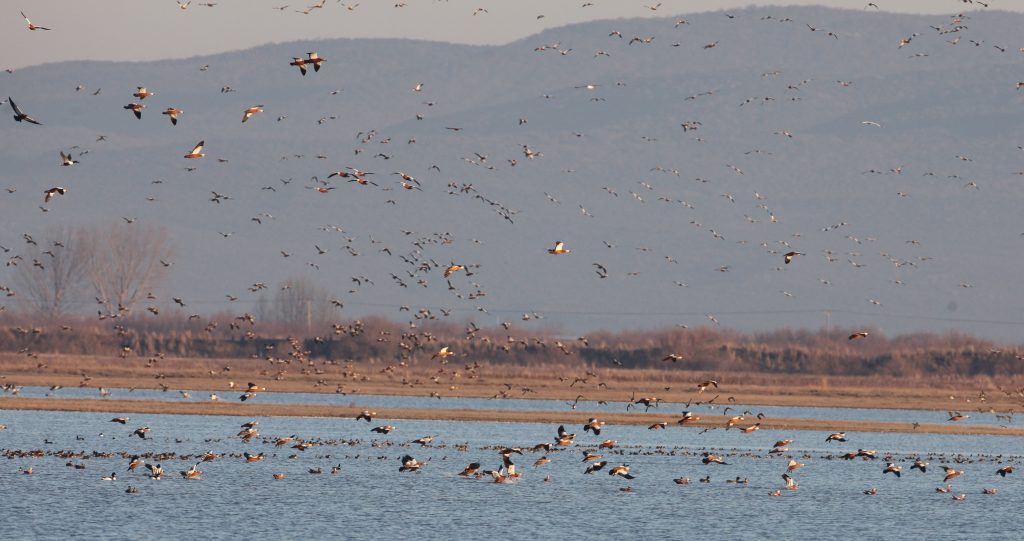
Go up tomorrow at 6:30, before sunrise, to see if the swans were indeed coming to sleep to Greece and to count them, if possible. And perhaps also to observe 854X!
A 30 % decline !
The Bewick’s Swan is really a beautiful bird. It is elegant, graceful. His social behavior is fascinating to observe. The parents care for their young for about a year, they migrate, winter together. Adult relationships are complex. They often communicate with each other with very melodious cries.

They sometimes intimidates each other, opening the wings, raising the neck, chasing each other.
They alternate periods of feeding and rest. By far, in polders of Flanders or the Netherlands, they look like pure white flakes. But in the evening, invariably, they fly off in well-structured flight to join their roosting place located on a large body of water, sometimes situated dozens of kilometers from their feeding site. As much as they are (relatively) tolerant to human activities during the day, they are on their guard after the arrival of darkness seeking to protect themselves from terrestrial predators by sleeping on water.
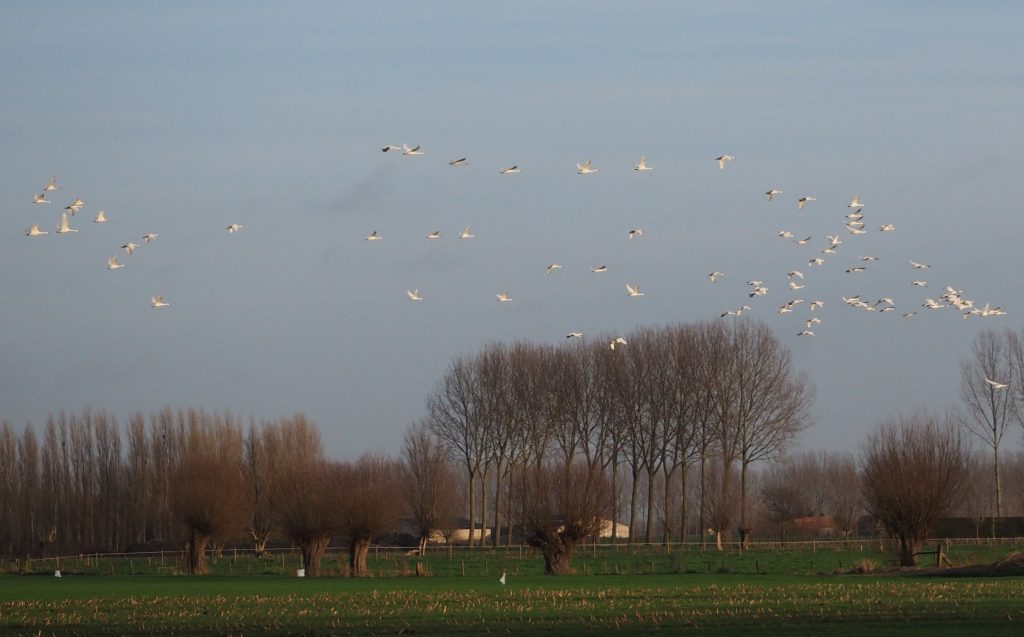
An idyllic situation? Not really. The number of Bewick’s Swans wintering in the North Sea area (from East to West in Poland, Germany, Denmark, Germany, Netherlands, Belgium and the British Isles) fell by 30% between winter 1994- 1995 and winter 2009-2010. The data of the last comprehensive count conducted a year ago (in January 2015) are not yet available. It seems that the negative trend has continued.
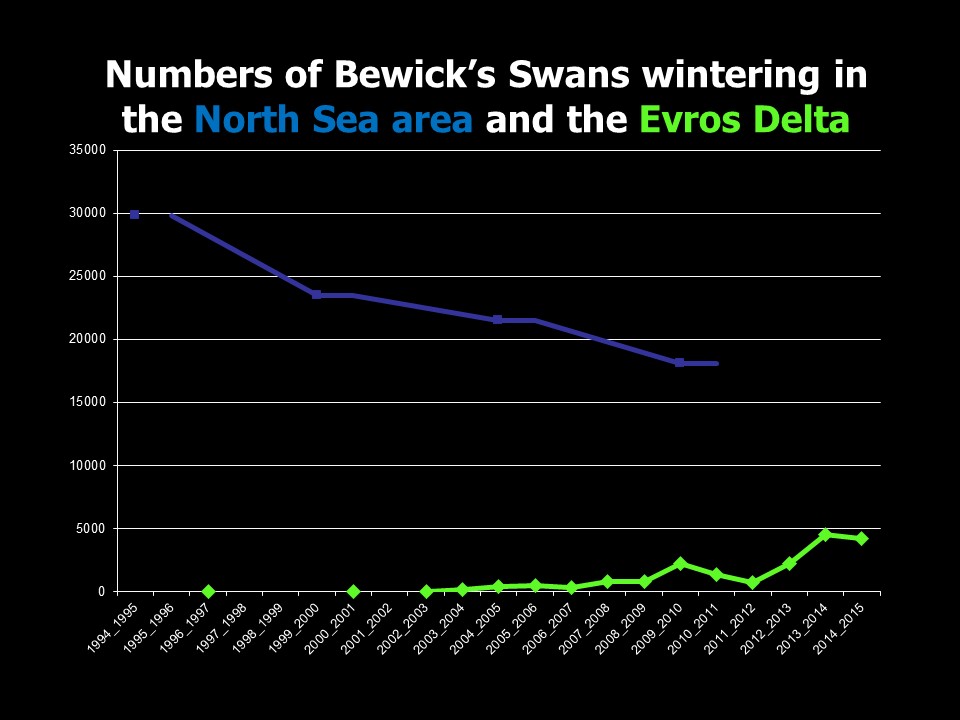
What are the reasons for this decline that can be described as catastrophic? They are largely ignored. But several worrying facts are observed: Bewick’s Swans wintering in the North Sea are have few offsprings (cygnets) in comparison with populations wintering in China and Greece. Over the last 10 winters, the average proportion of cygnets was 10.4%. The recorded maximum was 16.6% during the winter 2012/2013 and the minimum of 4.7% (which is very little!) in winter 2007/2008. These data were collected largely through hundreds of volunteer birdwatchers who count and observe the swans each winter. Furthermore, the British ornithologists of the renowned Wildfowl & Wetland Trust made a chocking statement. Since 2000, they X-rayed 47 Bewick’s Swans during ringing operations conducted in England. Among them, 22.7% contained lead shot. This suggests that despite their status of strictly protected species in the European Union and Russia, Bewick’s Swans are still regularly poached. Finally, and here are the Dutch ornithologists from the Institute of Ecology (Wageningen) who are leading, we observe that Bewick’s Swans regularly change food in recent winters and most of these are linked to human activities: meadows, plowing beets, potatoes, corn stubble. This behavior is it indicative of an unstable situation, unfavorable to swans? Studies are underway. And then there is the arrival, gradual but fast, of thousands of Bewick ‘s Swans in the Evros Delta in Greece. Is it there a cause and effect with the decrease of Bewick’s Swans in the North Sea area? Is it a population shift? Is this a good – or bad news? It is this that try to understand the Belgian, Russian and Greek partners this program.
We must quickly understand what’s going on!
He did it !
The Bewick Swan 854X that was since 51 days in the liman of Beisug on the eastern coast of the Sea of Azov (Russia) has arrived in the Delta of Evros, Greece. Incredibly, in this first year of the program, we drilled the mystery flyway who join the new Greek wintering site to the Siberian breeding grounds.
Let’s return to the events of the past days. 854X left the liman of Beisug on 10/12/2015 at about 08:00, around sunrise thus. He flies due west over the sea, through Crimea, overflying the lagoons of Sivash, reaches the Black Sea in the Bay of Karkinitsky, turns then towards the south-west along the west coast of Crimea, then rolls over straight until reaching Bulgaria via the Natura 2000 site of Durankulak, a few kilometers from the border with Romania.
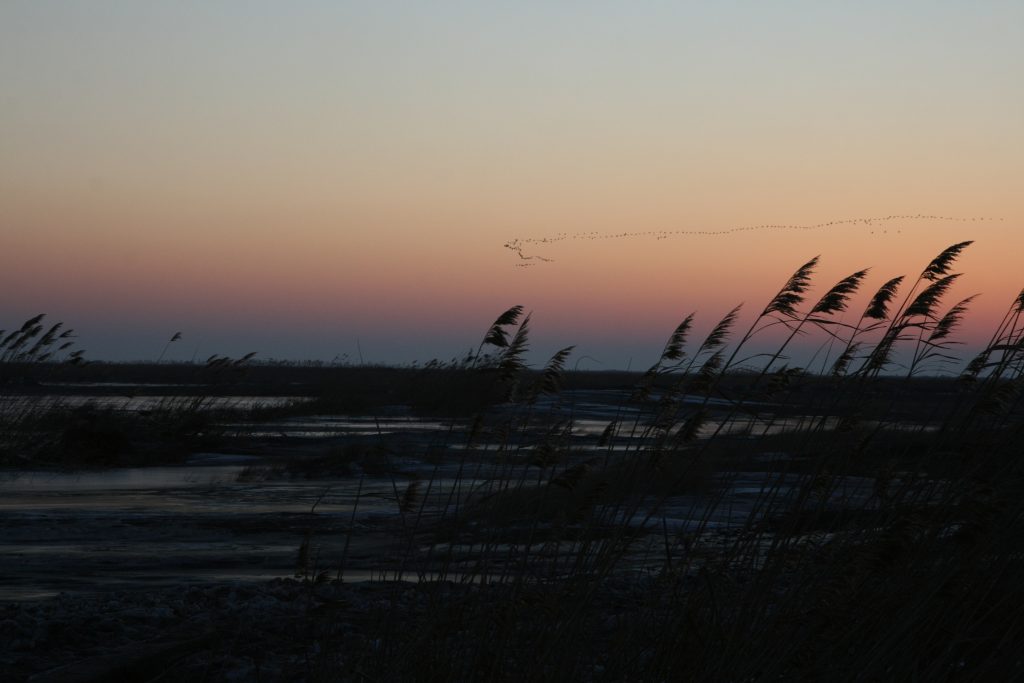
After 40 km flying over Dobrogea, it redirects to the south, finds back the sea up to the bay of Kavarna where he lands, 300 m offshore facing holiday resorts. It is about 01:00. This first part of the journey lasted 17 hours during which 854X has traveled at least 880 km with probably only one short stop near the nature reserve (zapovednik) Lebaj in Crimea. The calculated maximum flight speed is 91.6 km/h over three hours.
854X resumes migration around 08:00 again on 11.12.2015. He is heading inland, towards the southwest, for 95 km. Around noon, he changes track course and flies towards the northeast for 45 km. It takes a new bearing around 15:00 this time towards the southeast and finally stops on a small lake around 18:00, near the city of Blagovo. He spends there the night. Clearly 854X had a problem of orientation that day. He has traveled just 200 km. But he managed to compensate and regains its course for the next morning, when he first takes to the south-southeast for 23 km and then south for 270 km. He flies over Bulgaria, a short part of Turkey and then Greece entering the country at the height of the city of Orestiada. He joins there the Evros River valley. At 15:00, on 12/12/2015, 854X is located on the lagoon of Palukia in the middle of the Evros Delta National Park.
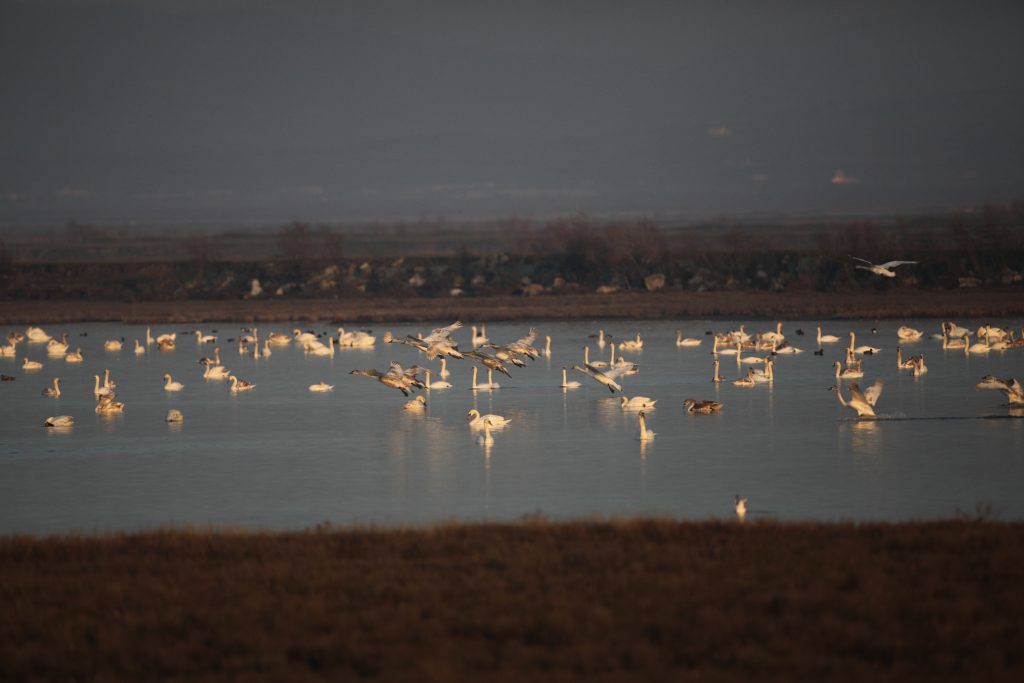
He left the tundra of Yamal 93 days earlier and has traveled in between some 5700 km, local movements during periods of stopover excluded. He has overfly Russia, Kazakhstan, the Ukraine, Bulgaria, Turkey and finally Greece.
Meanwhile, three other Bewick’s Swans tagged at the same time in Yamal are still on the Poyang Lake, 400 km from the coast of Sea of China and 7900 km of the Evros Delta!
Another route to … China!
The objective of this program is to understand how and why, within a few years, thousands of Bewick’s Swans have decided to spend the winter in the Evros Delta. Beyond that we hope to participate to understand why the population wintering in the southern North Sea region decline inexorably for 15 years. The first results are … totally unexpected!
The locations transmitted every three hours by the GPS/GSM transmitters carried on by the Bewick’s Swans we ringed in the Yamal Peninsula in August 2015 can be seen by logging on to the geographical application that is to access throughout the link right above this post.
The first two Bewick’s left the Yamal tundra on 11/09/2015. These are the swans 843X and 854X, both are immature males. The following three headed south on 14, 19 and 22 September. No transmission was received so far from the transmitter of the sixth swan, 801X. Is it the consequence of a technical problem? Was the transmitter lost in an area outside GSM network? Was the swan predated by a White-tailed Eagle? Each hypothesis is possible.
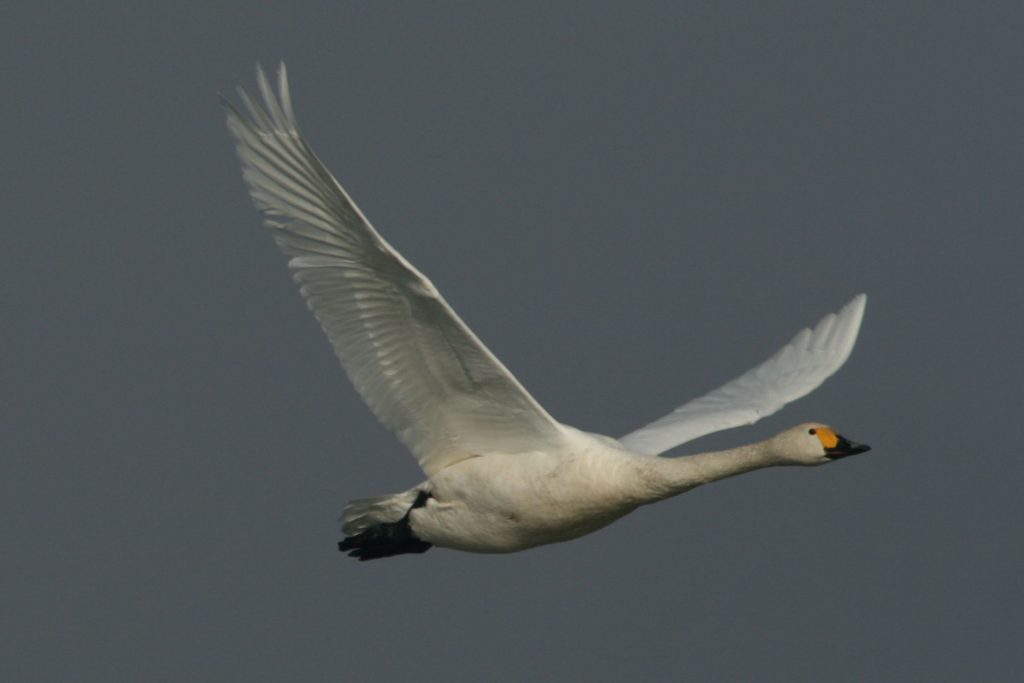
The five swans migrate separately, despite having been ringed in the same region within a few days. They all go south, flying over the taiga. But when in sight of Omsk and Novosibirsk regions, the swans 820X, 832X and 865X skew towards the east.
Between 30/09/2015 and 05/10/2015, these three swans stopped separately on Ubinskoye lake located 200 km from the city of Novosibirsk and 1650 km from the mouth of the Yuribey where they have been tagged. After a few hours or a few days stopover, each of the three leaved to the east-southeast, crossed Khakassia, flying over the Altai Mountains. 865X was the first to cross the border between Russia and Mongolia. But he quickly landed on Lake Uvs nur where he halted for two days. He then moved again towards the north, passing the Russian border again reaching a lake at 1200 m altitude near the town of Kak. He stayed there for 12 days. The 28/10/2015, in the early morning, he took the air again and traveled 3150 km in three days to reach the suburbs of Shanghai, China! INCREDIBLE ! After some hesitation, he landed on 01/11/2015 on Poyang Lake, one of the largest wintering site for waterfowl in China with a 3500km² surface and over 500,000 waterbirds counted during the winter. Of these, tens of thousands of Bewick’s Swans. Until now it was thought that these birds were originating from Eastern Siberia, and certainly not from Yamal peninsula situated just at the border with Europe. The Bewick Swan 865X traveled almost 6500 km in five weeks. On 26/11/2015, he was joined by 820X and 832X swans. Incredible triple!
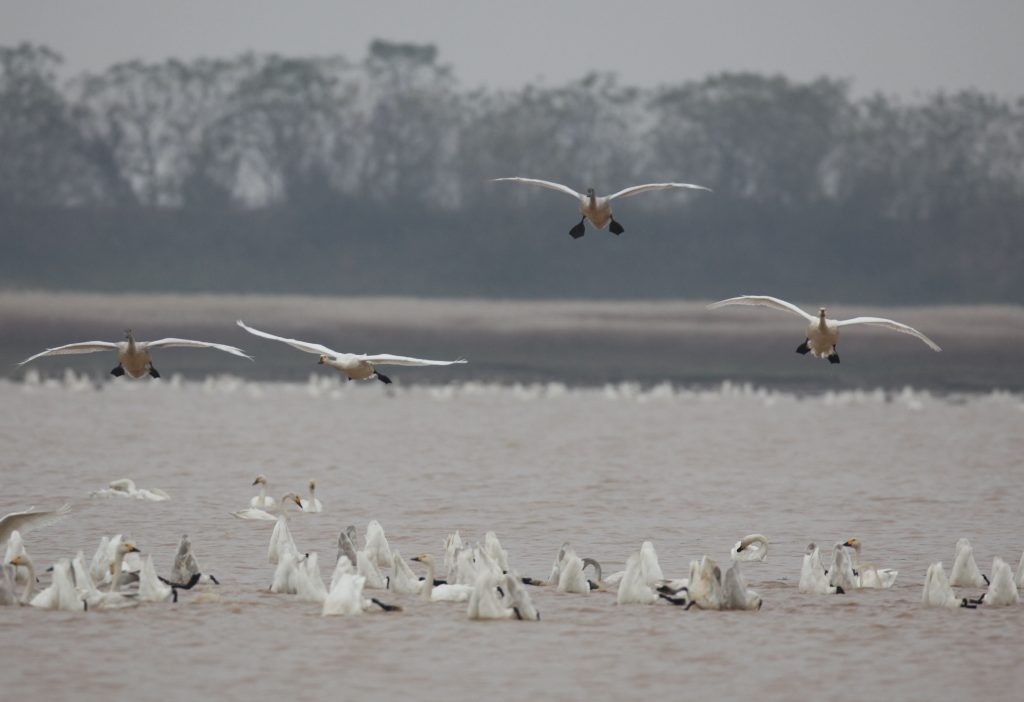
Two other swans also regularly transmit their position. After leaving from Yamal they headed also south overflying the taiga to reach the steppes of northern Kazakhstan. 843X travelled the route in one week. He stops on 18/09/2015 on a small lake and then another where he refueled until 17/10/2015. He flies at short distance only stopping next day on another lake located 270 km to the west. West ! So in the opposite direction of the three Bewicks en route to China! His logger is silent since. The swan 854X followed the same way. Between 5 and 21/10/2015, he stopped on a lake Akpas situated 100 km from Bewick 843X. He left the site to fly towards the southwest to reach the Caspian Sea. After a stop of less than 6 hours in the Volga delta, close to Astrakhan, he reoriented to the northwest, overflying – but not stopping – over the marshes of Kumo Manych where every Red-breasted Goose we had equipped with a transmitter in Siberian tundra during previous summers had a stopover. On 23/10/2015 at 11:00, 854X landed on the liman of Beisug on the east coast of the Sea of Azov.
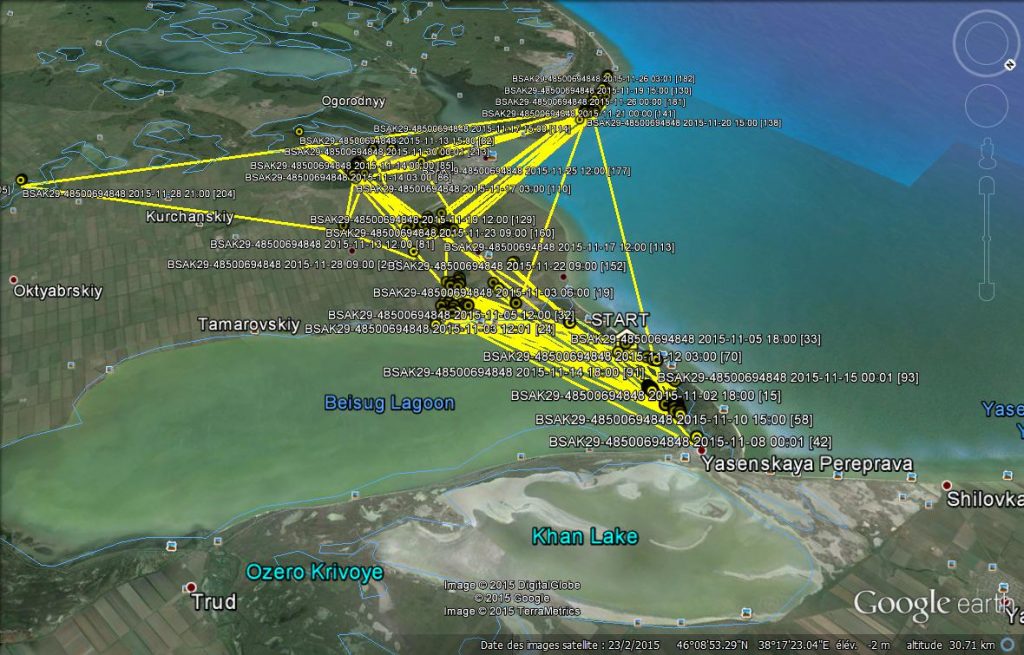
In less than 48 hours, 854X traveled 2300 km. What will he do next? Continue his journey to the west and join the Evros Delta and the Mediterranean? Or wintering in the Azov Sea? Both sites are only at 1100 km distance.
We are in a triple new situation!
843X will hopefully allow us to discover this new migration route that connects the tundra of Siberia to the Evros Delta via northern Kazakhstan and Azov Sea.
820X, 832X and 865X are in China, in the Yangtze River Basin. Probably no one imagined such a connection with the tundra of Yamal, so close to Europe.
Bewick’s Swans ringed from the same flock, at the same place, at the same time, are going to spend the winter in wetlands situated at 7100 km distance.
The geographical application to view the journey of the Bewick’s Swans equipped with a GPS/GSM transmitter in the peninsula Yamal was realized by Philippe Vandevondele and Yves Tassin from Intergraph Belgium (Hexagon Safety & Infrastructure).

